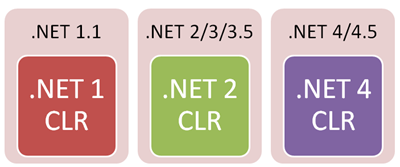The .NET Framework can version in two ways. There are "side by side
installs" and there are "in place upgrades." A major version means
side-by-side and a minor version means in-place.
Side-by-side means that different versions of .NET can live together on the same machine.

In-place upgrade means that the CLR is the same but new libraries are added as well as bug fixes and performance improvements:

There's been some concern about how .NET 4.5 is an "in-place upgrade" of
.NET 4. That means .NET 4.5 is still the v4CLR and adds new libraries
as well as improvements to the core CLR itself.
Note that this in-place replacement is very different from the side
by side installs of .NET 2.0 and 3.0/3.5 which all ran on the 2.0
version of the CLR. The two 3.x versions were basically library
enhancements on top of the core .NET 2.0 runtime. Both versions ran
under the .NET 2.0 runtime which wasn’t changed (other than for security
patches and bug fixes) for the whole 3.x cycle. The 4.5 update instead
completely replaces the .NET 4.0 runtime and leaves the actual version
number set at v4.0.30319.
Article ID: 377, Created: April 5, 2013 at 12:17 AM, Modified: April 5, 2013 at 12:18 AM